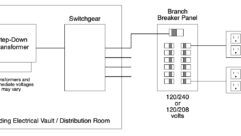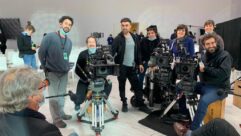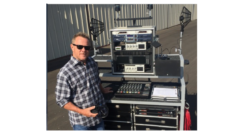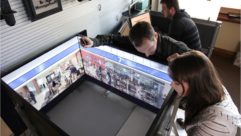
Picture This: Good, Best, Better
Apr 1, 2004 12:00 PM,
By Jeff Sauer
Mitsubishi MegaView rear-projection wall cube
Odd as it may sound, I heard a wonderful marketing presentation a couple of months ago at the Consumer Electronics Show (CES). In setting out his company’s display strategy for the next year, Toshiba’s vice president of marketing, Scott Ramirez, cleverly reshaped the Marketing 101 product line mantra of “good, better, best” to read “good, best, better.” He was talking about display technology, about flat panels, but it was a nice line, too, about understanding the options available and matching the right products with the needs of the client.
“Good, better, best,” of course, refers to a typical hierarchy of products that’s designed to satisfy consumers of different means. “Good” often offers fine quality but a limited set of features and special functions. “Best,” naturally, is for the person of means who can afford the very best. Unfortunately, with flat-panel displays, “best” is more exclusive than normal for the traditional “good, better, best” model.
In this case, “best” refers to flat-panel monitors and televisions, particularly plasmas, though as LCD panels increase in size, certainly they apply, as well. “Everybody wants what’s ‘best,’ of course,” says Ramirez, and he is right about flat TVs. You’d be hard-pressed to find someone who wouldn’t love to have a flat panel in a living room or boardroom.
In fact, I remember getting on a hotel elevator at CES in 1999 after seeing some early plasmas. A husband and wife in the same elevator were talking about how wonderful it would be to have a plasma. In just a few seconds, they summed up the diverse benefits of then-new flat-panel technology, complete with their priorities: better picture quality and better viewing angle for him; space-saving and subtle for her. Back then, however, plasmas started out at about $20,000 for 42-inch panels, and this couple wasn’t about to jump.
Today’s plasma prices are way down from those levels and are expected to continue downward, especially as competitive LCD panels increase in size and video performance. Today you can find 42-inch panels for well under five digits and often for less than $5,000. Still, that’s prohibitive for most consumers and for many businesses that might otherwise enjoy the benefits of a wallmounted flat panel.
So, suggests Ramirez, in today’s consumer environment where no one particularly wants to purchase just a “good” product that’s so central to family entertainment as a television, and where few can actually afford “best,” “better” actually makes a lot of sense. In this case, “better” is rear-projection TV, and, he noted, it’s going to be the volume sweet spot for large-screen TVs for a while.

Although rear-projection sets sit on the floor (in most cases) and are deeper than plasma and LCD panels, rear projection does take up less space than a large-diagonal CRT. Best of all for the consumer, rear-projection TVs start at less than half the price of same-size plasmas. As yet, LCD flat panels can’t even match the diagonal size of rear projection, although when larger LCD panels (greater than 42 inches) arrive later this year and over the coming years, prices will be far higher than for comparable plasmas.
LOOKING THINNER
What’s particularly interesting about rear projection, beyond the great price advantage, is that they are getting thinner, too. A year ago, Mitsubishi introduced the 60-inch rear-projection MegaView wall cube with a depth of just 10 inches. This year at CES, InFocus and Thomson announced their partnership to develop and brand a rear-projection model with a depth of less than seven inches. That “thinness” — a function of refined optical design rather than curved, warped mirrors — makes rear projection literally just a couple of inches fatter than a flat panel and should yield an evenly sharp image. The caveat is that these thin rear-projection models, which should ship later this year, are going to have prices that approach plasma levels: $8,999 for the 50-inch model and $9,999 for the 61-inch.
The Mitsubishi and the InFocus/Thomson models are based on DLP technology. That has helped reduced the size, just as DLP has done in the projector world. I expect LCD-based rear-projection monitor makers will announce reduced depths this spring and, mirroring the projector industry, at comparatively lower prices.
Toshiba’s CES product lineup for 2004 TV included “good, better, best” products, and Ramirez assured the audience that he’d be happy to sell any of them to customers. Yet in a sector that increasingly follows the computer industry model of announcing products well in advance of their true availability or practicality, Ramirez was also astute to point to a viable solution for today’s market and price expectations.
Admittedly, that’s hardly a lesson that any successful integrator needs to hear. You sell today what you have, and you work with the products and tools you know. But that approach, when taken to an extreme, can be dangerous if it leaves clients doubting the end result because they feel certain options or information might have been suppressed. What makes the tweaked “good, best, better” approach clever is that rather than climbing a proverbial hierarchy of value and quality and stopping at an affordable level, it implies that a client understands the whole picture.
PHAT AND ALL THAT
In this case, that means recognizing that plasma is cool and flat is phat — but also that rear projection can match the flat and even offer higher resolution. If you need a place for your DVD player and other components anyway, then thinness might matter a little less. More important, the client has done his or her own rationalization, and the salesperson has been forthcoming.
Jeff Sauer
writes the “Picture This” column for
Sound & Video Contractor
and is a contributing editor for
Video Systems
. He can be reached at
.










